No-Knead Maple Oat Bread
This post may contain affiliate links. Please read my disclosure policy.
Sweetened with maple syrup and loaded with oats, this fresh maple oat bread is baked in a loaf pan, comes together in no time, and is so, so tasty. The oats give the bread a nice chew, and the whole wheat flour lends a heartiness, making it an excellent toasting bread.

One of the recipes from my cookbook, Bread Toast Crumbs, that trips people up the most is the oatmeal-maple loaf. It’s a simple no-knead recipe, just like all of the others in the book, but the process is slightly different, and the written format, as a result, is also different.
In short, in this recipe, the water gets added in two phases: first, the oats, maple syrup, and salt soak in 1 cup of boiling water for 10 minutes; then more water gets added along with the yeast and flour.
Because my publisher only includes water in the ingredient list if it is “boiling” or “lukewarm” or “ice cold”, etc., only the 1 cup of boiling water is listed in the ingredient list. You are instructed to add the remaining water at the end of step 1.
Many people over the years have missed this detail and have made the recipe using only 1 cup of water, and when their oatmeal-maple bread has baked into a doorstop, they’ve emailed me wondering why.
It always makes me sad, because I love this one so much — the oats give the bread such a nice chew, and the whole wheat flour lends a heartiness, making it an excellent toasting bread.
After sharing the recipe for the loaf pan peasant bread over on Cup of Jo, I thought it might be nice to revisit this one and re-write it for a single loaf pan, since most people have one, and include all of the water in the ingredient list to prevent the production of any more oatmeal-maple doorstops.
A Note on Whole Wheat Flour
The original recipe calls for a mix of whole wheat flour and white flour. In this recipe, rather than using commercial whole wheat flour, I’m using stone-milled flour from Cairnspring Mills. I’ve written about the benefit of using stone-milled flour in this post, the most compelling reason being that stone-milling preserves more of the bran and the germ, which is where many of the nutrients, antioxidants, oils, and flavors are stored. Industrial mills remove this germ in order to create a shelf-stable product.
As an experiment, I made one loaf with commercial bread flour exclusively and one loaf with a mix of commercial bread flour and stone-milled flour, and while they both were good, the one made with stone-milled flour was superior in both flavor and texture.
I find locally milled stone-milled flours at a local co-op, Honest Weight Food Co-op, and I also order online from various sources. Here are a few I love:
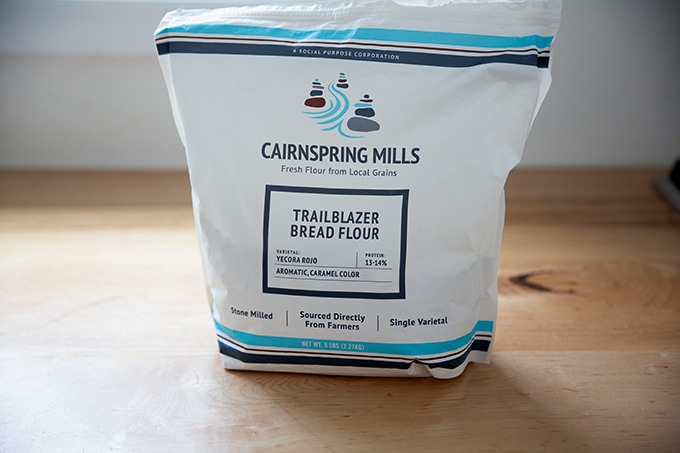
How to Make Oatmeal Maple Loaf, Step by Step
First, gather your ingredients: flour, salt, water, oatmeal, maple syrup, and instant yeast (SAF is my preference).

In a large bowl, combine the oats, salt, maple syrup, and 1 cup boiling water. Let stand for 10 minutes. Then add 3/4 cup cold (or room temperature) water.

Sprinkle the yeast over the top and stir to combine.

Add the flour or flours: I’m using a mix of 1 cup Trailblazer Bread Flour and 2.25 cups King Arthur Flour bread flour.
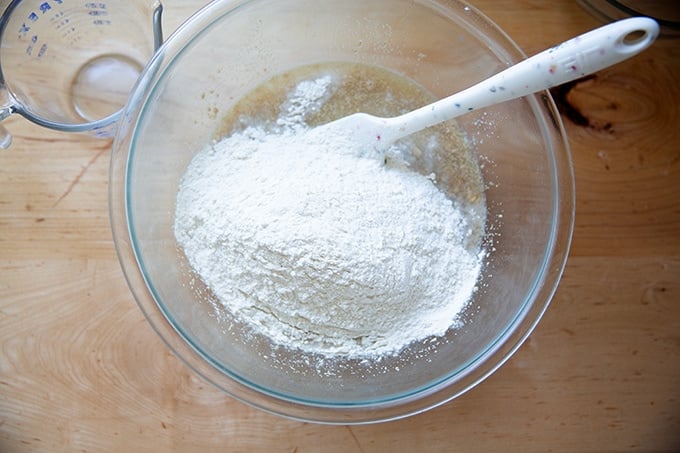
Mix until you have a sticky dough ball — you may need to knead with your hands to get the dough to come together into a ball.

Cover the bowl and let rise in a draft-free spot for 2 to 3 hours …

… or until doubled in volume:
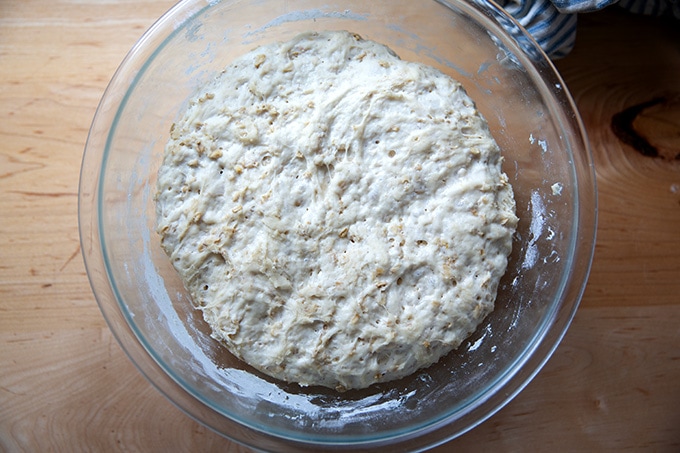
Once doubled, slick the surface with a little olive oil and release it from the sides of the bowl.

Turn the dough over, roll it into a coil or a loaf shape, and place it in a buttered loaf pan coated with oats.
Sprinkle oats over the surface of the dough as well. Let rise for another 45 minutes to an hour or …

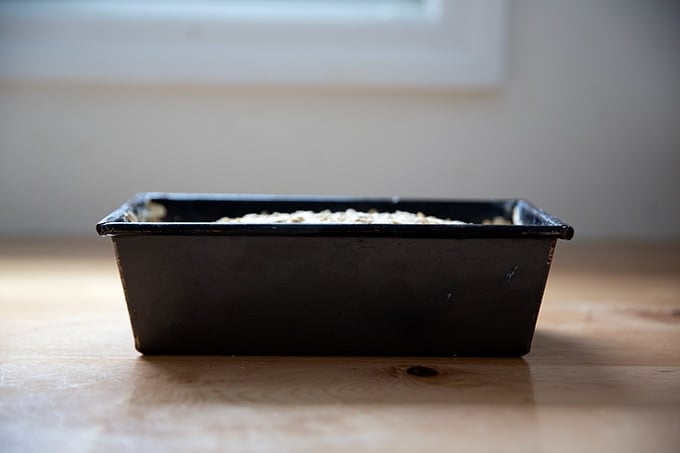
… until the dough has risen considerably. Transfer to the oven and bake for 45 minutes at 375ºF.


Let cool for at least 30 minutes before slicing.

This is a side-by-side comparison of a loaf made with all bread flour (on the right) and one made with a mix of stone-milled flour and bread flour (on the left). It’s a subtle difference but the loaf on the right is slightly loftier.
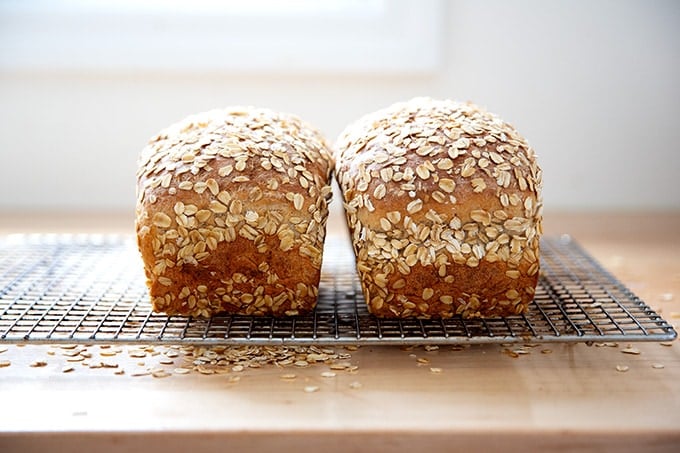
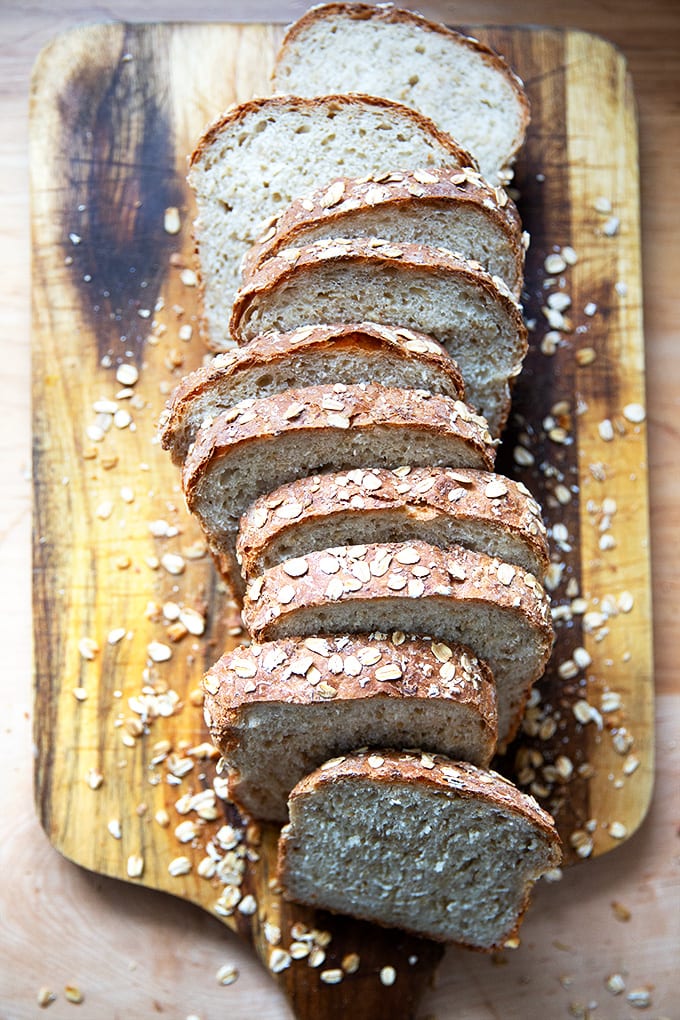
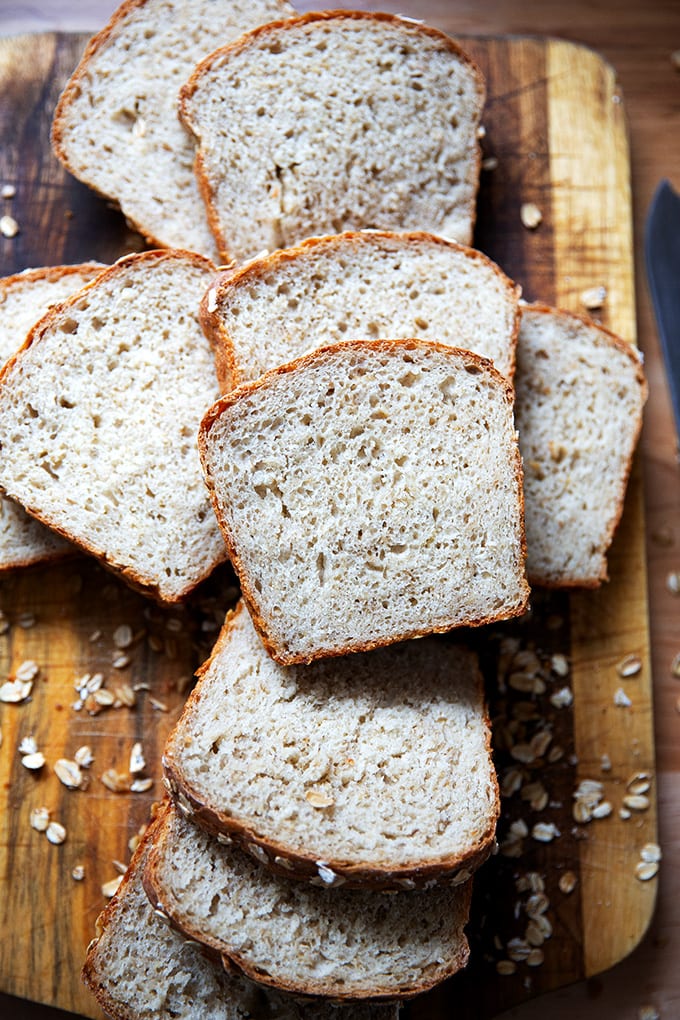
Toast and slather with butter.

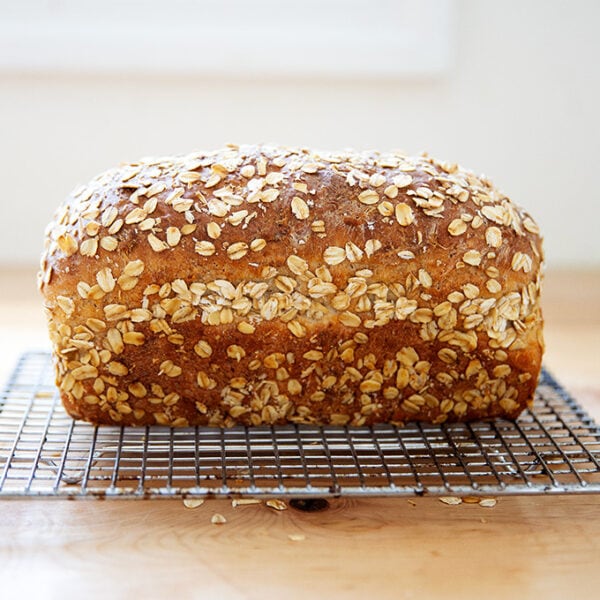
No-Knead Maple Oat Bread
- Total Time: 5 hours 45 minutes
- Yield: 1 loaf
- Diet: Vegan
Description
Sweetened with maple syrup and loaded with oats, this fresh maple oat bread is baked in a loaf pan, comes together in no time, and is so, so tasty. The oats give the bread a nice chew, and the whole wheat flour lends a heartiness, making it an excellent toasting bread.
Adapted from my cookbook, Bread Toast Crumbs.
Changes from the original recipe include:
- The vessel: This one is baked in a single loaf pan as opposed to two 1-quart Pyrex bowls. You can use an 8.5×4.5-inch pan or a 9×5-inch pan. I prefer the 8.5×4.5-inch pan for this one because it creates a slightly taller loaf.
- Flours: The original recipe calls for a mix of white and whole wheat flour. Rather than using commercial whole wheat flour, I’m using stone-milled flour, which is more nutritious and more flavorful. Read more about it here or up above in the post.
- Water: I’ve cut the water back by 1/4 cup because I was finding my finished loaf to be a little too damp for my liking. With this slightly smaller amount of water, the dough is a teensy bit stiffer and therefore requires a bit more time to rise.
If you like this recipe, find 40 variations in my cookbook:
Ingredients
- 1 cup (88 g) rolled oats plus another 1/2 cup (44 g) for coating the pan
- 1 cup (227 g) boiling water
- ¼ cup (86 g) maple syrup
- 1.5 teaspoons (5 g) kosher salt
- 3/4 cup (170 g) room-temperature water
- 1.5 teaspoons (5 g) instant yeast
- 2¼ cups (288 g) unbleached bread flour or all-purpose flour
- 1 cup (128 g) stone-milled flour or whole-wheat flour, see notes above
- Softened unsalted butter, for greasing
- 1 tablespoon olive oil
Instructions
- In a large bowl, combine the oats, boiling water, maple syrup, and salt. Let stand for 10 minutes. Add the remaining 3/4 cup (170 g) water and stir to combine. Add the instant yeast, and stir to combine. Finally, add the flours and stir with a rubber spatula, until the liquid is absorbed and the ingredients form a sticky dough ball. You may need to knead the dough with your hands briefly to help the dough come together, no more than 15 to 30 seconds.
- Cover the bowl with a tea towel or plastic wrap and set aside in a warm spot to rise for 2 to 3 hours, until the dough has doubled in volume.
- Preheat the oven to 375ºF. Grease an 8.5- x 4.5-inch (or 9×5-inch) loaf pan generously with softened butter. Pour the remaining 1/2 cup of oats into the loaf pan and turn the pan so that the oats coat the pan on all sides. Pour out the remaining oats and set aside.
- When the dough has doubled, drizzle the tablespoon of olive oil over the top and use your hand to rub the oil over the surface to coat. Use your hand again to release the dough from the sides of the bowl, then flip the ball over so that the oil side is down. Roll the dough into a coil or into a loaf shape (see video in the post above), then transfer to your prepared pan seam side down. Pour the reserved oats over the top, then spread with your hand or shake the pan to distribute them.
- Let the dough rise on the countertop (preferably in a warm, draft-free spot) for 45 minutes to an hour or until the dough has risen significantly in the pan — it should be doming above the rim of the pan by about one inch. See photos for reference.
- Transfer the pan to the oven and bake for 45 minutes, or until the top is evenly browned. Remove the pan from the oven and turn the loaf out onto a cooling rack. Let the loaf cool for at least 30 minutes before slicing.
- Prep Time: 5 hours
- Cook Time: 45 minutes
- Category: bread
- Method: oven
- Cuisine: American
This post may contain affiliate links. Please read my disclosure policy.

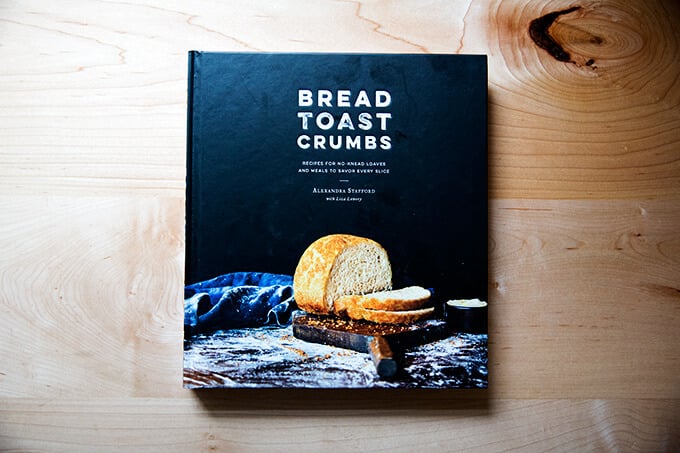










151 Comments on “No-Knead Maple Oat Bread”
Could I substitute spelt flour for the whole wheat? Looks like a beautiful loaf.
Yes!
This was one of my favorite recipes from Bread, Toast, Crumbs! The flavor reminds me of the brown bread from Cheesecake Factory! Thanks for modifying it for a loaf pan!
So nice to read this, Sonia! Thanks so much for writing 🙂 🙂 🙂
This looks great! But I’m a little confused—-do we roll the dough into a coil in the bowl or take the dough out of the bowl onto the counter? I’m looking forward to baking this loaf!
In the bowl! I did not do a good job of documenting that step and will add a photo the next time I make it. I simply flip the dough over in the bowl, roll it up, then transfer it to the loaf pan.
Could you make this bread and let it rise overnight in the refrigerator so that you could bake first thing in the morning?
Yes! I would up the yeast to 2 teaspoons if you’re going to stick it straight in the fridge — it will help it along in the cold environment.
This is one of my go to recipes from bread toast crumbs! But I love them all! Anyway I always wonder if I can use leftover oats from the week to make this though? Would I use 1 cup of cooked oats in place of the 1 dry and boiling water?
Oh that’s such a good question! When you make your oats, how much water do you use and how much oats?
I went back to my notes of the original recipe in the book and wrote that I almost forgot that cup of water but then caught it!
That is interesting that you cut back on the water by 1/4 cup. Do you find in general what when you use the Trailblazer flour you have to use a tablespoon more water per cup as the package suggests? Sorry if you already addressed this and I missed it.
Hi! I’m so glad you made a note! I find the format frustrating especially with the peasant bread “formula” because once people get the hang of the method, they look at the other recipes and don’t even need to follow the instructions because basically everything always gets mixed together in one step. There are a few other recipes in the book that follow this format and I should make a list and create a troubleshooting page… I’ve been meaning to do this!
Anyway: because almost every bread recipe I make is very high hydration, I don’t find I need to adjust the water when I use Trailblazer bread fluor. Generally, whole wheat flours and freshly milled stone milled flours are “thirstier” and do require more water, but it’s all relative to the recipe you are using.
For this recipe, 2 cups of water for 3.25 cups of flour is a lot of water. Of course there are the oats, which soak up some of the water, but I just found the cooked loaf to be very wet, almost undercooked with the full 2 cups of water. That said, I probably could have baked the loaf longer which might have solved the issue, too.
I have made this recipe from your cookbook in the two Pyrex bowls. We love it and I can’t wait to try it in a single loaf pan!
So nice to hear this, Noelle 🙂 🙂 🙂
Is this available in GF version?
I’ve been making your GF peasant bread now over a year and sing your praises to everyone. But it would be really nice to have a variety in making bread.
Hi Erika! Unfortunately I do not have a gf version of this one, but I think you could adapt the gf peasant bread recipe to make it work by using 1/4 cup maple syrup (in place of the 2 tablespoons honey) and simply adding 1 cup of oats, which I would soak with 1 cup of boiling water for 10 minutes first. Then add the remaining 1 cup of water, and proceed.
Does that make sense? I think you could fit the entire amount of dough in a 9×5-inch loaf pan or larger. Do you have one?
Well, sitting on my pantry shelf is a bag of stone ground dark rye, have no idea why I purchased it maybe to try a savoy rye biscotti who knows, but, anyway can I sub 1cup for the whole wheat?? Will additional water or yeast be needed because of rye being a heavier flour??? Anxious to try this recipe!
Hi Nancy! I would start with 1/2 cup (64 g) rye because I worry the loaf will be very dense if you use a whole cup of rye. I have a rye bread recipe in my book and the ratio in that recipe is about 25% rye. For this recipe, 25% rye would amount to about 100 grams or 0.8 cups, which I would round down to 3/4 cup if you wanted to go with the higher amount of rye. In sum, I’d say start with somewhere between 1/2 and 3/4 cup rye; then adjust the recipe the next time around based on your results.
This looks really good! Can you explain what you mean by roll the dough into a coil? I’m having trouble visualizing that step. Thank you!
Hi! I just added up above a 20-second video that shows the process … it’s really just a matter of rolling the dough into a roll. Hope it helps!
I had the same coil question this morning, but just rolled it up into a loaf shape. I didn’t think to read these comments. The bread smells amazing.
I think “rolled it up into a loaf shape” is a better description, Cindy! I’m going to make a note. Thank you 🙂 🙂 🙂
Thank you!
Hi! Is it okay to use quick oats?
Should be fine!
I have made so many of your bread recipes, both sourdough and yeast, and this one does not disappoint. The flavor is amazing!!!!! Your recipes make me feel like an accomplished bread baker. Thanks for your great content!
Awww so nice to read this, Liliana 🙂 🙂 🙂 Thanks so much for writing.
Definitely one of my favorites! Wondering if this could be adapted to sourdough version?
Definitely! I would simply add 100 grams of starter (as opposed to subtracting flour and water from the current amounts) and omit the yeast, obviously, and I would bake it in a 9×5-inch loaf pan… the 8.5×4.5-inch pan will be too small, I think, with 100 grams more dough. Let me know if you need further guidance.
Made it today — delicious! – and it’s almost gone. Can this recipe be doubled?
Thanks.
Yay 🙂 🙂 🙂 So nice to hear this, Grace. Yes, absolutely, double away.
Hi
What can substitute the wheat and all pirpose flours with?
Bharti
Hi! Are you trying to make this gluten free? Can you clarify your question?
This turned out great! I used KA whole wheat and bread flours. This recipe will definitely be on rotation – really delicious and so easy.
Great to hear, Amy! Thanks so much for writing and sharing your notes 🙂
LOVE this loaf! Tastes good and looks really attractive as well. I used unbleached K.A. bread flour only and it worked great.
For recipes that call for oats, I prefer to use Bob’s Red Mill Extra Thick Rolled Oats instead of regular or quick-cook.
I really like the taste of oats; can oat flour be added in place of some (1/2-1cup) of the bread flour? Does that mean I would have to add more yeast and/or water and/or sweetener?
Susanna in Seattle
p.s. I made the same mistake when I first made this bread (as many others apparently also made) missing the second 1-cup water. Maybe for a reprint, the instructions to add that second cup of water could be BOLDED or underlined if it can’t be in the ingredient list?
Forgot to add my rating!
So great to read this, Susanna! Thanks so much for writing and sharing your notes. My mother is a big fan of those thick rolled oats as well. And I love them, too.
Regarding the oat flour, I’m not exactly sure how to advise, but I wouldn’t add much more than 1/2 cup for fear of the bread turning very dense. I don’t think you’ll need to add more sweetener or water. And I actually don’t think more yeast will help either. I would substitute by weight 1/2 cup oat flour for the same amount of bread flour; then adjust your formula next time around depending on your result.
And yes to BOLDING and UNDERLINING for a reprint. Thanks, Susan 🙂
Hello again Alexandra,
Thank you so much for your considered response to my question about oat flour. I abandoned that idea but am now playing around with a mix of steel-cut and thick rolled oats in a slightly larger quantity (100-110 grams) than you use in your recipe. So far, all experiments have yielded edible bread so I’m happy!
After baking several loves in standard loaf pans, I made my first Oatmeal-Maple loaf in the small (4x4x9) USA Pullman Loaf Pan and absolutely loved the result. So tall, so square, so STRAIGHT. But still a bread with personality because of the domed top!
Thanks again for another opportunity to play with bread!
Susanna in Seattle
Yay!!! I’m so happy to read all of this. I LOVE that straight-sided pan. It’s such a fun shape. Thanks for writing and reporting back. I’m so glad the oatmeal bread turned out well in it!
I thought Id try this bread – it sounds so good. Anyway – Im at Walmart and not seeing a stone ground whole wheat and was wondering if I could use walnut flour? I know its odd but I thought Id give it a try. It just me and I dont want to buy a huge thing of WW flour since I dont make bread regularly. Ill try it and let you know.
Hi Tina! Walnut flour unfortunately will not work — because there it does not contain gluten, your loaf will be very, very dense.
This is excellent. Soooo good toasted w some butter on it. I ate like a quarter of the bread the day I made in and tried it the next day toasted and buttered and it’s spectacular. Especially given how little work it took to bake it. I did make it in a much bigger pan- I used my 2pound Pullman loaf pan bc I like a skinnier loaf of bread. It was a bit too big for the bread but my regular loaf pan which is 9×5 would have been too small I think. I used regular whole wheat instead of stone milled flour bc that’s what I had. Thanks for yet another perfect recipe Alexandra
So nice to hear this, Nazanin 🙂 🙂 🙂 Thanks so much for writing and sharing your notes. You can definitely use your 9×5-inch loaf pan here, but if you like the shape using your pullman pan, keep using it. So glad you liked it!
I have used your other recipes but in this case the dough was really dry and had to add more water but it still does not look like your video. I am in the rising portion of the recipe so will see Scott
Hi Scott! Are you using a scale to measure? And you did add the full amount of water, correct? 1 cup (227 g) + 3/4 cup (170 g)?
Can this recipe be made with just all purpose flour, or is a secondary type of flour a requirement. Thanks in advance.
No need to use a secondary type of flour! All all-purpose is fine.
How would I go about replacing some of the flour and water with sourdough discard? Thank
you for the guidance.
I would use 100 grams starter, and I would subtract 50 grams each flour and water to compensate for the flour/water provided by the starter. Hope that helps!
Can this recipe be doubled to make two loaves at the same time?
Yes!
Hi Ali,
I made it twice already. Great flavor, fabulous toasts with jam or almond butter, or butter only. Another great recipe from you.
Once the bread is cooled, it is so soft, I really have a hard time slicing it, any hints for me? I think maybe next time, I will put it in the freezer for 1 hour or so, would probably be easier to slice…
Great to hear Lou! Freezing it is a good idea or even refrigerating it (in an airtight bag in either location). I wonder if maybe you need to reduce the water? Are you using a scale to measure?
Hi,
I meant freezing the bread a while to make it easier to slice if it was half frozen.
Yes I am using a scale, and used your proportions in grams. I live in Montréal, QC, could it be the flour? I think I remember reading one of your post mentionning something about Canadian flour being different from USA flour. I did an overnight proofing in the fridge, and the dough tripled! I used a 5 x 10 Chicago metallic pan, which was the perfect size. Last week I used a 4,5 x 8,5 which was too small, the dough overflowed in the oven. Maybe too much water. Do you get a crispy crust once your bread is cooled ? Thanks
It’s definitely the flour! Are you using all-purpose or bread flour? When I’ve troubleshooted with other Canadians over the years, using bread flour solves most issues or using less water from the start. Bummer to hear the 8.5×4.5 was too small, but I’m glad you have a 10×5-inch pan that works well. Once cooled, the crust is no longer crisp until I toast it. I always recommend heating up day-old bread before serving — the toaster works great or you can use your oven if you are heating up more than a few slices.
Bonjour Ali,
I’ve used unbleached all purpose flour and stonemilled integral whole wheat bread flour. I will reduced the quantity of water next time; will let you know. Looking forward to try your no-knead three-seed bread, looks delicious.
Thanks so much for your help!
Good luck, Louise! I think reducing the water or using a white bread flour in place of the all-purpose flour might help.
Hello Ali,
I’m a little confused. The recipe above says this makes 1 loaf. And the recipe in the book says 2 loaves. Does this mean I have the option to make either 2 Pyrex bowls or 1 loaf pan instead ? Thanks for your help.
Yes, exactly!
He aprendido mucho sobre esta receta. En general, me parece que cocinar es una actividad muy satisfactoria, ya que te permite experimentar con diferentes ingredientes y técnicas, para crear platos deliciosos. Además, cocinar puede ser una forma maravillosa de unir a amigos y familiares alrededor de una mesa. He encontrado este blog por internet, a través de Google; me ha llamado mucho la atención por sus recetas.
Has anyone tried this substituting honey for the maple syrup? I like it with the maple but am curious to try it with a honey flavor unless that would change the texture drastically.
Honey should work great! I’d use an equal amount.
I tried making this and I love the subtle sweetness of maple and oats! But my loaf came out to be quite dense. I’ve used all bread flour for the loaf, could that be the reason why it turned out dense?
Hi Heidy! Are you using a scale to measure? And what type of flours are you using?
Yes, I’m using a scale to measure and I’m using purely bread flour.
OK, great to hear. I don’t think bread flour is the reason, though you certainly could try with ap flour and see if it makes a difference. Does the first rise go OK? As in, does it double in volume? And when it’s proofing in its loaf pan, is rising quite high above the rim before you bake it?
Yes, the first rise doubled in volume before I transfer it to the loaf pan for the 2nd proofing. It rise quite high above the rim after around 30mins so I went ahead to pop it into the oven to bake it.
Well, it sounds as though you are doing everything right, so I’m not sure how to advise. I suppose the next step would be trying all purpose flour. You could also try SAF instant yeast, if you are not already. I swear by it. Also: this bread definitely is on the dense side, so it’s possible that it turned out as it should 🙂
Wonderful bread! This recipe is a keeper for sure. The only issue I had was that once the bread was baked, all the oats on the outside fell off as soon as I handled it to cut slices. What’s the secret to getting them to stick? I think I brushed the loaf with butter before sprinkling on the oats–maybe that was the problem?
Also, instead of wheat, I used stone milled spelt flour which is less dense and has such a lovely nutty flavor. How much of the white flour do you think I could safely replace with spelt?
Thank you for posting this recipe! I’ve been trying out different no knead breads since my stand mixer died, and so far this one is my absolute favorite. Once you get used to eating homemade bread every day, the store bought stuff doesn’t even taste real. 🙂
So nice to read all of this, Allison 🙂 🙂 🙂
I would try 50% spelt flour and see how you like it; then adjust with more or less next time around depending on your results.
Regarding the oats falling off… I get a lot of oats falling off as well. I don’t brushing the loaf with butter would have caused more oats to fall off, I think they’re just hard to keep stuck to the loaf. I made a note in the 3-seed bread recipe I posted recently that so many of the seeds fall off. It’s not quite as bad with the oats, but they do not adhere perfectly either. If I find a solution, I will update the recipe!
I think it’s just nuts that recipe templates don’t let you list water as an ingredient. The New York Times does this and I always complain about it in the comments. Perhaps you could get around it by listing it as “room temperature” water.
Totally agree! It makes no sense at all. It’s an outdated rule that should be outlawed!